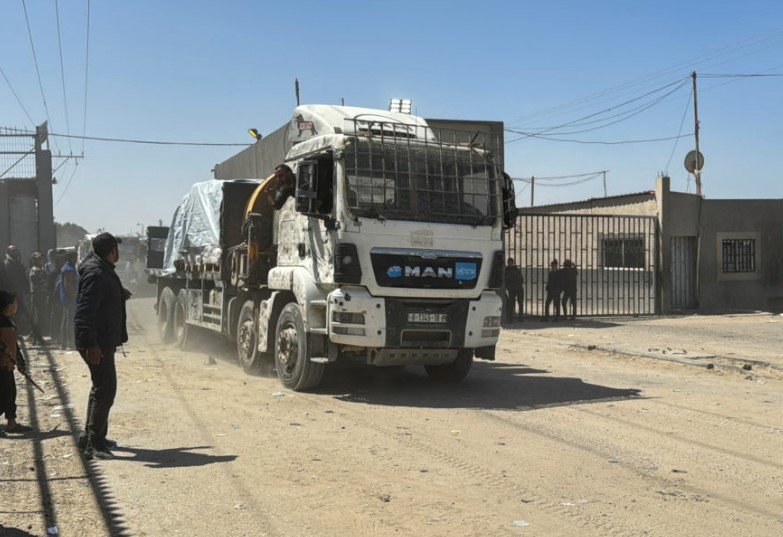Ex-US envoy calls Israeli claims “knowingly false” as piles of aid remain stuck at Gaza border crossings
Tensions between Israel and international aid groups boiled over this week as David Satterfield, Washington’s former special envoy for humanitarian affairs in Gaza, openly criticized Israel’s narrative that blames the United Nations for the worsening humanitarian catastrophe inside the besieged enclave.
His remarks follow an Israeli army media tour at the Kerem Shalom border crossing, where piles of food and medical supplies were showcased—untouched, unmoved, and reportedly undelivered by international agencies. But Satterfield says that’s a distraction from the real reasons aid isn’t reaching those who need it.
Israel Shifts Blame as Starvation Deepens
After months of denying or downplaying the scale of hunger in Gaza, Israeli officials now say food is there—but claim it’s being withheld by others. That’s a major rhetorical pivot.
On Thursday, a senior Israeli military officer stood at the Kerem Shalom crossing, pointing toward the rows of idle aid packages. “This is not on us,” he told reporters. “The United Nations isn’t picking them up.”
That’s now become Israel’s core message: The aid is coming in, but the UN isn’t doing its job.
But critics say that’s an oversimplification—at best.

Satterfield Calls Out “Knowingly False” Narrative
Satterfield, who led U.S. humanitarian efforts during the early months of the war, did not mince words.
“It is disingenuous — knowingly false — for any party to assert that it is failure, lack of courage, or deliberate conspiratorial withholding of aid by the UN or international organizations that is responsible for the humanitarian suffering in Gaza,” he told The Times of Israel.
One sentence. Brutal.
His rebuke adds fuel to a growing fire of international frustration, where many see Israel’s statements as attempts to deflect from its own role in paralyzing Gaza’s aid lifelines.
Why Aid Is Actually Stuck
The problem, aid groups say, isn’t about trucks sitting idly. It’s about what happens after they cross into Gaza.
• Aid convoys are regularly looted by desperate civilians—some organized, others random
• Routes inside Gaza are dangerous or impassable due to ongoing combat and destroyed roads
• Humanitarian workers lack safe corridors to move goods from crossings to warehouses or distribution points
And then there’s the chaos.
“There is no functioning civil authority in many parts of Gaza,” one UN staffer in Rafah said, speaking anonymously. “Sometimes we literally have no one to hand the aid over to. That’s the breakdown.”
Logistics Meet Lawlessness
The Kerem Shalom crossing may appear orderly in Israeli footage, but things quickly deteriorate just meters beyond.
Two aid workers interviewed by Reuters last week described scenes of “pandemonium” where trucks were stripped within minutes. Children climbed onboard. Men carried off sacks on bicycles. No police. No peacekeepers. No plan.
“You can’t just dump aid at the fence and call it a delivery,” said a senior Red Crescent official.
Some routes have been completely overtaken by armed gangs, several aid groups claim. One convoy was forced to turn around last week after being threatened.
UN Pushes Back Quietly — But Firmly
Publicly, the UN has tried to avoid a loud confrontation with Israel. But behind the scenes, there’s deep frustration.
An internal OCHA (UN Office for the Coordination of Humanitarian Affairs) document reviewed by Foreign Policy stated:
“Without reliable security guarantees or operational space, the volume of aid delivered cannot increase meaningfully.”
UNRWA, which has handled most Gaza aid since the 1950s, has also been caught in political crossfire. Israel accuses it of ties to Hamas; donors have slashed funding. That’s left fewer trucks, fewer staff, fewer options.
A War of Optics and Accountability
This conflict isn’t just on the ground. It’s in the headlines. It’s on the screens.
The Israeli government has become increasingly media-savvy, arranging controlled tours of border areas for international journalists. On these trips, reporters see wrapped pallets, labeled boxes, visible expiration dates—meant to signal that the problem lies elsewhere.
Satterfield’s statement throws a wrench into that strategy.
Table: Breakdown of Reported Aid Challenges (July 2025)
| Challenge Type | Description | Source |
|---|---|---|
| Insecure Routes | Looting, attacks on convoys | UN OCHA |
| Lack of Storage | Warehouses destroyed or non-functional | UNRWA |
| Short Staff | 70% cut in international aid worker presence | ICRC |
| Delayed Clearances | Israeli inspections delaying urgent shipments | WHO |
| Fuel Shortages | Preventing refrigeration and transport | WFP |
The View from Washington: No Illusions
The Biden administration has tried to walk a diplomatic tightrope—supporting Israel while urging humanitarian restraint.
But Satterfield’s comments hint at a shift, or at least a deepening unease.
This is not a fringe voice. He was handpicked by the White House. He’s worked in Beirut, Damascus, Baghdad, Jerusalem. He knows the politics. He knows the tactics.
And he’s saying the truth is more complicated—and more uncomfortable—than it looks from the Israeli side of the border.
Aid Isn’t Just a Logistics Problem — It’s Political
Ultimately, everything about Gaza right now is political, even the bread and baby formula.
-
Israeli leaders worry that any humanitarian relaxation could help Hamas regroup
-
Palestinian groups blame Israel for collective punishment
-
Aid workers feel caught in a no-man’s land with no good options
And the people? They’re stuck in the middle. Again.
“We’re trying to feed families, not fight narratives,” said one WFP coordinator. “But every day feels like a new PR war.
